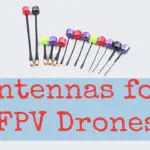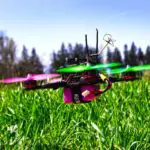I was building my first drone, and was bewildered by the specs of the flight controller. I thought probably many beginners out there are equally confused as me when choosing an FC. Hence, I’ve consolidated the best FPV flight controller in the market. I’ll also show you how to choose the right flight controller for your quads.
- What is a Flight Controller?
- Best Flight Controller 2024
- How to Choose a Flight Controller for FPV Drone?
- Processors or Micro Controller Unit
- Firmware
- Number of UART
- Built-in Inverter
- Gyroscope and Accelerometer
- Current Sensor
- On Screen Display
- BEC
- Radio Receiver Compatibility
- Mounting Pattern
- Black Box
- ESC Integration
- Barometer
- GPS
- Soft Mounting Gummy
- Power Distribution Board
- Camera Menu Control
- Bluetooth Capability
- FC/ESC Stacks
- Final Thoughts
What is a Flight Controller?
Before we get into the details of the features, let us first understand what an FC is.
The flight controller is basically the brain of your drone. It takes commands from you through the radio, and executes them. For instance, when you push the throttle, your FC receives the input, processes it, and instructs the electronic speed controller to speed up the motor.
On top of that, FC also contains a few sensors and modules such as the gyroscopes, accelerometers, GPS, OSD, and etc., which gives you a better experience with drones.
Best Flight Controller 2024
There are lots of different FC in the market and it can be overwhelming to choose the right one. Below is my top pick for your consideration.
Note that I’ve included affiliate links below. If you make any purchases through my links, I will get a small commission for qualified purchases. This helps me to maintain the site without additional cost to you.
Hobbywing XRotor Micro Combo Stack

Hobbywing is one of the most reliable brands in the FPV hobby. Its latest, high-quality FC stack is packed with all features that you need in FPV.
The FC has both 20×20 mm and 30.5×30.5 mm mounting holes to fit different drone frames, but you can only use the 30.5×30.5 mm mounting if you are using the stack. I suggest buying the stack, because Hobbywing builds the best ESC.
The XRotor Micro stack comes with 6 UARTs, 2 BEC, built-in OSD, a DJI plug-and-connect port, a data flash chip for black box logging, and supports Betaflight. One key downside though, is that it doesn’t support Bluetooth.
MATEKSYS F722 HD

The MATEKSYS F722 HD is specifically designed to support DJI FPV system. This FC runs on a powerful F7 processor and is packed with a lot of useful features, such as telemetry, voltage sensor, black box, beeper, RSSI (signal strength) and etc.
For long range and autonomous flight, the MATEKSYS F722 HD can be switched to iNAV to support more GPS features, such as return home, waypoints etc.
Mamba F722 APP

Mamba F722 APP is powered by an F7 processor. It allows you to remotely configure your drone through the SpeedyBee app, which is very convenient.
It has 6 UARTs, which is more than enough for normal use. The FC also comes with a black box, and supports OSD.
The ESC in this stack is quite decent. It runs BLHeli_32, and can support up to DShot1200.
T-Motor Mini F7

If you are looking for something small (20×20 mm mounting) and powerful, the T-Motor Mini is the best option.
T-Motor Mini is a small FC powered by an F7 processor. It has all the core features that you’d expect from a decent FC.
If you plan to build a drone with the Air Unit, the Mini F7 can be connected to the Air unit without soldering.
Diatone Mamba F405 Mini MK4 Stack

The Mamba F405 Mini MK4 is a tiny FC/ESC for those who has budget concern. The FC runs on a F4 processor, which is enough for a basic build. It doesn’t have built voltage/current sensors, RSSI, beepers or telemetry. But it has 6 UARTs, which is quite sufficient for basic use.
GEPRC F411 AIO – Budget-friendly AIO for Toothpick Quads
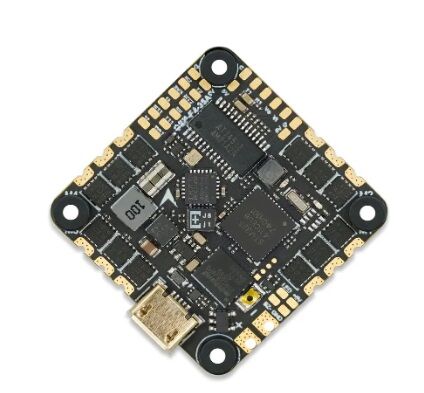
Overall, this is a great AIO flight controller that offers excellent value for the price. It is perfect for anyone looking for a high-performance, easy-to-use flight controller for their toothpick build.
Pros:
- High-quality components
- Easy to use
- Great performance
- Budget-friendly
Cons:
- Only two available UARTs
- No 9 V or 12 V voltage regulator
FlightOne MillivoltOSD

This list is not complete without the FlightOne MillivoltOSD FC. FlightOne products are optimized for racing. If you are into racing, this is definitely something to consider.
The FlightOne MillivoltOSD FC runs on an F4 processor. It has built in OSD and telemetry support, and is able to support a wide range of radio. It also features a 20602 gyro with 32 kHz sampling rate, and grommets for soft mounting are included.
If you hate soldering, you will love the MillivoltOSD because it has connectors for the peripherals.
While the MillivoltOSD specs might not look impressive if compared to other FC, bear in mind that it runs on FlightOne, which is tuned for racing. That means in terms of racing, it outperforms other FC running on Betaflight with the exact same specs.
SpeedyBee F405 V3
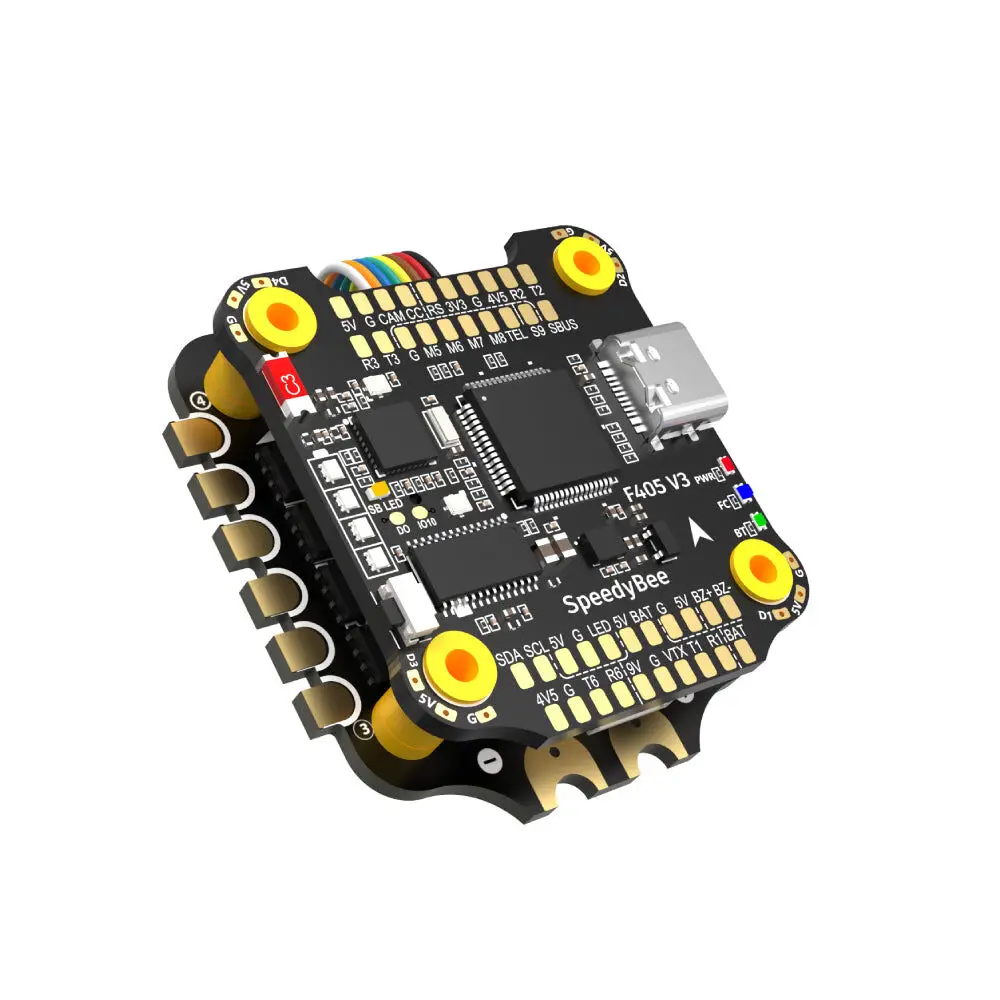
The SpeedyBee F405 V3 is a flight controller stack that offers exceptional value for its price. It boasts features like Bluetooth pairing and configuration, onboard battery indicators, a built-in barometer, and ample UARTs, BECs, and soldering pads. While it may not have all the bells and whistles of high-end flight controllers, its performance and durability are impressive, making it a top choice for budget-conscious drone enthusiasts.
Pros:
- Affordable price point without sacrificing essential features.
- Built-in Bluetooth for wireless configuration.
- Integrated LED battery indicator.
- Sufficient UARTs for peripherals.
- Includes an SD card slot for blackbox logging.
- Reliable performance and durability.
Cons:
- Uses an F405 processor, potentially limiting the maximum loop rate.
- ESC runs BLHeli_S firmware instead of BLHeli32, lacking some advanced features.
To conclude, the SpeedyBee F405 V3 stack is a remarkable value proposition, delivering a feature-rich and reliable flight controller and ESC combo at a fraction of the cost of many standalone flight controllers. While it may not be the absolute top performer in terms of processing speed or ESC features, its overall performance and value make it an excellent choice for those seeking a budget-friendly yet capable setup for their drones.
Flywoo Goku GN745
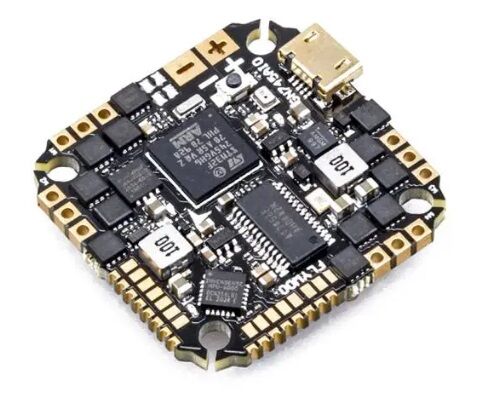
The Flywoo Goku GN745 AIO flight controller is a top-of-the-line flight controller with impressive features and specifications. It boasts an F7 processor, BLHeli32 ESC, and supports advanced features like bidirectional DSHOT and RPM filtering. The inclusion of a barometer, voltage regulators, and 8MB of blackbox memory further enhances its functionality.
Pros:
- Powerful F745 processor and BLHeli32 ESC
- Supports advanced features like bidirectional DSHOT and RPM filtering
- Includes barometer, voltage regulators, and 8MB blackbox memory
- Integrated 5V/9V dual BEC, WS2812LED, and 7 hardware serial ports
Cons:
- Soldering to the board might be slightly more challenging due to the solder pad placement
The Flywoo Goku GN745 AIO flight controller is a top-tier choice for those seeking exceptional performance and a wide array of features in a compact package. While soldering might require a bit more finesse, the unparalleled feature set and advanced capabilities make it a worthwhile investment for serious drone enthusiasts and racers.
How to Choose a Flight Controller for FPV Drone?
Choose an FC with an F4, or preferably F7 or H7 processor. Make sure it supports Betaflight. Most FPV pilots prefer using MPU6000 gyro. Current sensor, extra UARTs and black box are desirable addons to your FC. Ensure the FC can fit into your drone frame, and compatible with your radio receiver.
There are a lot of features that an FC may have. Some are basic requirements while some are good-to-have features depending on your need. Let’s drill in a little bit further on the details of those features.
Processors or Micro Controller Unit
Like your computer and smartphone, the FC has a processor which is also known as the micro controller unit (MCU) that processes information. The processing power is measured in MHz. The higher the processing power, the more information your FC can process in a given time.
Unlike Intel or AMD processors, it is very simple to compare the performance of FC processors by name. The F1 processor is the oldest processor while F7 is the latest. Naturally, the F7 that has 216 MHz processing power is stronger than F4s with 168 MHz. And there is a faster and pricier processor called the H7 with a whooping 480-500 MHz.
You should get an FC with at least an F4 processor. Anything lower than F4 is obsolete. Given most developments or improvements that are based on F7 onward, F7 or H7 is your best option if you want to enjoy the latest and future features.
Firmware
Firmware is basically a type of software used to run your FC. You can configure a lot of settings through the firmware. The common firmware used are Betaflight, FlightOne, and KISS.
The most popular firmware used is probably the open source Betaflight. Betaflight has a clean and easy to use user interface. This should be your first option because you can easily get help when facing issues, given the large user base it has. Most of the FC in the market would support Betaflight so there are a lot of options for you.
On the other hand, FlightOne is specifically tuned for racing. It removes unnecessary codes to free up more processing power to focus on speed. The interface is user-friendly as well. FlightOne is the go-to firmware if your main purpose is racing or freestyle. Having said that, there are very limited numbers of FC that support FlightOne.
KISS or Keep It Super Simple is another powerful firmware by FlyDuino. The user interface is probably the simplest. It runs only on KISS FC so your choices are limited. In terms of performance, KISS is no lesser than Betaflight or FlightOne.
Certainly there are many other firmware available, such as LibrePilot, Butterfly, dRonin and etc. However, those are not as popular. So, expect lesser options and probably lesser support when using those firmware. Keep in mind that a firmware may become obsolete if there aren’t enough users to support its development.
Number of UART
UART or Universal Asynchronous Receiver/Transmitter is the “port” that allows you to connect devices such as radio receiver, telemetry and VTX to your FPV flight controller.
UART acts like an USB port of your laptop where you use it to connect your mouse or pen drive, but instead of 1 port, it works in pairs. Each UART has 2 pins: a receiving (RX) and transmitting (TX) pin. Each pin has a number and pins of the same number (eg. TX1 and RX1) should be connected to the same device. The TX of your FC connects to the RX of your peripherals and vice versa.
In essence, the more UARTs you have, the more peripheral you can connect to your FC. Try to get an FC with extra UART than what you need, so that you can add extra parts onto your FC in the future, unless you are sure that you don’t need them.
Built-in Inverter
Some of the radio receivers (eg. FrSky receivers) use the SBUS protocol which gives out inverted signals. This is not recognized by older FCs (F4, F1). Newer FCs like F7 have built-in inverters to handle the inverted signals.
Newer F4 FCs do come with built-in inverters. If you plan to use F4 FCs, make sure they have built-in inverters (usually the UART labeled as SBUS) to read the inverted signals. Otherwise you will have to go through the hassle manually inverting the signal through hardware or software (Betaflight).
You don’t need this if you are not using a receiver with inverted protocol.
Gyroscope and Accelerometer
Gyroscope (gyro) and accelerometer are the 2 basic sensors that each FC would have. They are collectively called the inertial measurement unit (IMU).
The gyro uses gravity to sense the orientation or rotation of your drone; on the other hand, the accelerometer detects acceleration. In FPV racing, we need only the gyro since we are flying in acro mode. The accelerometer can hence be turned off to free up the processor.
The most commonly used IMUs are from InvenSense. There are 2 series available: the MPU and ICM. The MPU6000 is the most popular IMU used in FPV. It features up to 8 kHz sampling rate.
While the MPU6500 and the ICM series have a higher sampling rate at 32 kHz, which is technically better than the 8 kHz sampling rate, they are rather sensitive. Electrical noises and physical vibration can easily affect the performance of over-sensitive IMU. Hence, MPU6000 is probably the best gyro for you.
If you want to use a gyro with higher sampling rate, choose the ICM20602 which has the best sampling rate and lowest noise. Make sure it comes soft-mounted on the FC, which would reduce some noises.
You should also soft-mount your FC to reduce noises that affect the performance of the FC. Another trick is to include capacitors in your setup to reduce the electrical noises from your motors and ESC.
Note that the latest Betaflight version caps the gyro sampling rate at 8 kHz to achieve better performance, even if your gyro can support faster sampling rate than that.
Current Sensor
The current sensor measures the total amount of current drawn and the rate of current drawn.
By monitoring the total current drawn, you can prevent the damage from over discharging your battery and from crashes since you know when to land before your battery runs out.
For instance, if you are using a 1050 mAh battery and you have drawn 950 mA, it’s time to land. Because battery capacity degrades over time (which means a 1050 mAh battery will hold less than 1050 mAh as it ages), current reading should be used in conjunction with a voltage sensor to determine when to land. Calibration might be required to make the sensor accurate.
You also want your ESC to be able to support the maximum current drawn. For instance, if your ESC supports up to 30 A, you don’t want it to draw more than that. With the current sensor, you would know if the current draw rate exceeds what your ESC supports.
Whenever possible, make sure your FC has a current sensor.
On Screen Display
On screen display or ODS is the key function that you should have in your FPV drone. It allows you to see information from various sensors and components such as altitude, speed, GPS, battery voltage, current consumption etc on your FPV screen.
Nowadays, all FC should support OSD.
In the context of FPV racing, you would want to have the OSD so that you can land your drone before the battery runs out. You also want to be able to adjust the video transmitter setting through the OSD if your VTX has Smart Audio/Tramp, otherwise known as VTX telemetry or VTX control.
BEC
Many FCs have at least a 5 V battery elimination circuit or BEC. It basically allows you to power up your drone components such as the VTX or camera. Some of the FCs have more than 1 BEC and can supply up to 12 V or more. Make sure the BEC supports the voltage of your drone components that it needs to power up.
Of course, some of the components can be powered up from the LiPo battery directly. However, with BEC you have more options.
Radio Receiver Compatibility
Depending on the brand, your radio receiver/transmitter communicates using different languages or protocols. That includes PPM, SBUS, DSM2/X and etc. While most FC would support multiple protocols, it is good if you can make sure that your FC can support the protocol used by your radio receiver.
Mounting Pattern
The sizes of the FPV flight controllers are quite standard, and are measured as the horizontal and vertical distances between the mounting bolts. You have the 16 x 16 mm for 2” drone, 20 x 20 mm for up to 4” drone, and 30.5 x 30.5 mm for 5” drone.
You want to make sure that the mounting pattern fits your frame.
Black Box
Black box is a useful feature for advanced pilots who want to improve their flight. Similar to the black box in an aircraft, the black box on the FC captures your flight log which contains information such as current draw, vibration etc.
The flight log is stored either in an SD card or integrated flash memory. You can then extract the information for analysis and subsequently improve your flight through PID tuning. File transfer from SD cards will be faster and more convenient than from the flash memory.
In short, a black box is worth having but not a deal breaker.
ESC Integration
You will sometimes find variants of FC with integrated ESC. They are called the all in one or AIO FC/ESC.
With integrated ESC, you can save some effort from soldering the 2 components together, and also a few grams in weight.
However, you will need to change the whole thing once it fails, which can be more expensive than changing only the FC or ESC.
AIO FC/ESC is suitable for smaller drones that have limited space to slot in the chips.
Barometer
The barometer basically detects the atmospheric pressures to estimate the altitude. The higher the altitude, the lower the atmospheric pressure. If you are flying a long range or autonomous drone, you would need a barometer to keep your drone at a fixed altitude. But for FPV racing, a barometer is not required.
GPS
Global Positioning System, or GPS, provides the geocode of your drone. It helps you to identify the location of your drone if you lost it. This is suitable for long range and autonomous drones. However, we don’t need it for FPV racing.
Soft Mounting Gummy
Some of the FC comes with soft mounting gummy. It helps to reduce the vibration caused by the motor that can affect the performance of your gyro. This would improve your flight and make it smooth.
Having a soft mounting gummy will eliminate the hassle to manually soft mount your FC. Hence, it is definitely something to consider when selecting your FC.
Power Distribution Board
A power distribution board or PDB is an essential component that distributes the power from the batteries to different components (such as ESC and VTX) in your drone.
Most of the FC available in the market today has an integrated PDB. This reduces the overall size and weight of your build, which is important especially if you are flying a small drone.
Camera Menu Control
Some of the FC have the camera menu control feature. It allows you to change the setting of your camera such as brightness, resolution etc. through your radio transmitter. It gives you some level of convenience, but it is not something that you must have on your FC.
Bluetooth Capability
Some of the FC support Bluetooth. That allows you to configure your Betaflight settings using a mobile app. Without that, you have to connect your FC to a computer to change the setting.
This is a good to have feature but not a deal breaker. After all, you don’t have to change your setting that often.
FC/ESC Stacks
You might see FC stacks when shopping for an FPV flight controller. It is simply a combo of FC and ESC. Buying stacks is usually cheaper, and the connection between the 2 boards can be usually done without soldering.
Final Thoughts
While there are more to share about FPV flight controllers, I focused on what I think is crucial for FPV beginners. Surely there are more useful features, especially sensors if you are using your drone outside FPV freestyle or racing. Those will probably be the topic of another article. I hope that this guide is helpful for you in choosing the right FC for your FPV drone.


